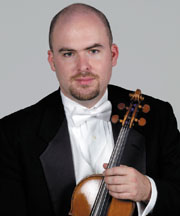![]() Criticism
Criticism
![]() Criticism
Criticism
An enthralling tour of contemporary practice
From Stravinsky’s Petrushka to Mark Fewer’s spectacular six- string electric violin performance, the VSO bookends nearly a century of music
by David Gordon Duke
Two works new to Vancouver and one 20th-century classic made for great listening Saturday in the first program of the VSO’s 2005–06 “Great Classics” series.
Michio Kitazume’s Ei-Sho (Dawn Light) was first played in Japan just over a decade ago to considerable acclaim. Despite a couple of well-paced climaxes, Ei-Sho is, for the most part, a study in pastel neo-Impressionist colours for large orchestra. Kitazume’s material is ephemeral but full of charm and sophistication. For the careful listener it’s a tour de force of contemporary orchestral practices, held together by an imaginative and poetic sensibility.
 The Dharma at Big Sur by California’s John Adams showcases the six-string electric violin, spectacularly played by VSO concertmaster Mark Fewer. A piece d’occasion commissioned to celebrate the opening of L.A.’s new architectural landmark, Disney Hall, it’s a fundamentally accessible, entertaining work. If Fewer’s new instrument takes a bit of getting used to, Adams’s now-familiar idioms — soft, foggy brass, vital post-minimalist rhythms, discreet use of synths — come together in a sort of Jack Kerouac-meets-the Pacific Rim synthesis of no great depth but substantial appeal. The first movement, A New Day, begins where Adams’s 1979 Simple Tones in Common Time left off, in an exploration of “just” intonation. Many of the solo passages are embellished with portamentos in an evocative (but facile) homage to Asian musical traditions. The subsequent Sri Moonshine is a full-out romp, driving inexorably to an ecstatic conclusion.
The Dharma at Big Sur by California’s John Adams showcases the six-string electric violin, spectacularly played by VSO concertmaster Mark Fewer. A piece d’occasion commissioned to celebrate the opening of L.A.’s new architectural landmark, Disney Hall, it’s a fundamentally accessible, entertaining work. If Fewer’s new instrument takes a bit of getting used to, Adams’s now-familiar idioms — soft, foggy brass, vital post-minimalist rhythms, discreet use of synths — come together in a sort of Jack Kerouac-meets-the Pacific Rim synthesis of no great depth but substantial appeal. The first movement, A New Day, begins where Adams’s 1979 Simple Tones in Common Time left off, in an exploration of “just” intonation. Many of the solo passages are embellished with portamentos in an evocative (but facile) homage to Asian musical traditions. The subsequent Sri Moonshine is a full-out romp, driving inexorably to an ecstatic conclusion.
The 1947 version of Stravinsky’s Petrushka completed the program, a welcome sequel to Maestro Bramwell Tovey’s brilliant Rite of Spring last season. Petrushka’s status as one of the great orchestral classics was never in doubt: after almost a century, its boundless energy and ineffable freshness remain a wonder.
In his platform commentary, Tovey revealed something of his own background with dance. Even if we hadn't been told, we would have recognized a pragmatic and experienced ballet connection in his interpretation. This was a reading that kept the narrative thread of the music foremost: all Stravinsky’s carefully conceived descriptive moments were effective but kept subordinate to overall dramatic continuity. Orchestral playing was of near-uniform quality, clean and nicely balanced. Though the revised version of the score includes a concert ending, Tovey wisely kept to the original. Stravinsky’s strange, inspired conclusion worked magnificently: an edgy note of pathos and irony and an eerie shiver or two to round out a memorable evening.
Vancouver Sun
7 November 2005
 archives
archives